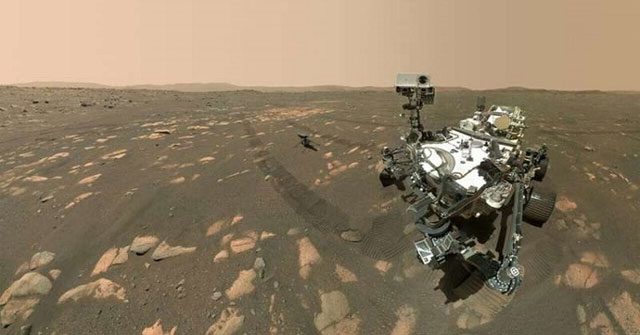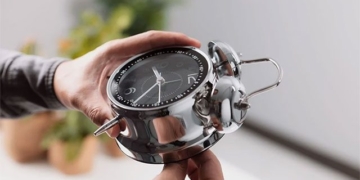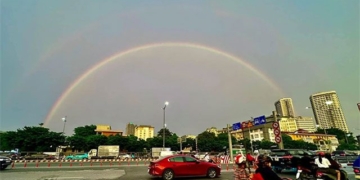The United States National Aeronautics and Space Administration (NASA) shared a color video revealing how the Perseverance rover took a ‘selfie’ alongside the Ingenuity helicopter on April 6.
 Perseverance rover takes a selfie with Ingenuity helicopter. Photo: NASA.
Perseverance rover takes a selfie with Ingenuity helicopter. Photo: NASA.
The selfie allows engineers to check for wear and tear on the rover while also inspiring the community. Additionally, the microphone capturing the rover’s atmospheric entry, descent, and landing recorded the sounds of the motors running throughout the process.
Video from one of Perseverance’s navigation cameras shows the robot’s arm moving to capture 62 frames that form the composite image. The selfie was created with the help of a core team of about 12 people, including rover operators, testing engineers at the Jet Propulsion Laboratory (JPL), and camera operation engineers who specialize in developing sequences, processing images, and combining the photos. The entire team took a week to prepare all the necessary instructions.
JPL collaborated with the Malin Space Science Systems (MSSS) in San Diego, the organization responsible for building and operating the selfie camera. Named WATSON (Wide Angle Topographic Sensor for Operations and eNgineering), this camera is primarily designed for taking detailed close-up images of rock surfaces rather than wide-angle shots. Since each image from WATSON captures only a small portion of the scene, engineers had to instruct the rover to take dozens of pictures to create the selfie.
NASA engineers explain how Perseverance took the selfie. Video: JPL.
Once the images were received from Mars, the image processing engineers at MSSS got to work. They corrected any blurriness caused by dust on the camera’s light-sensing equipment. Then, they stitched the frames together to create a composite image and removed the seams using software. Finally, an engineer distorted and cropped the composite image to make it resemble a photo taken with a regular camera that people are accustomed to seeing.
Like the Curiosity rover, Perseverance also features a rotating turret at the end of its robotic arm. Along with other scientific instruments, the turret houses the WATSON camera, which points its lens at the rover while taking the selfie. The robotic arm acts as a selfie stick and is not included in the final image. Commanding Perseverance to take the selfie is significantly more challenging than with Curiosity. While Curiosity’s turret has a diameter of 55 cm, Perseverance’s turret is considerably larger, measuring 75 cm in diameter.
JPL developed software to ensure the arm does not collide with the rover. Each time a collision risk was detected based on simulations conducted on Earth, the engineering team adjusted the arm’s direction. This process was repeated dozens of times to ensure the arm’s movement was safe. The final command sequence positioned the arm as close to the rover as possible without hitting it. Engineers also ran simulations to ensure that the Ingenuity helicopter was correctly positioned in the final selfie or that the microphone could capture sounds from the motors in the robotic arm. The sound of the motors running resembled music echoing through the rover’s chassis.





















































